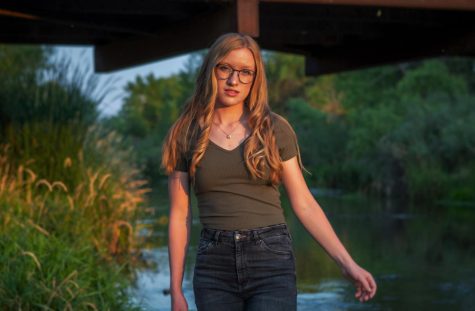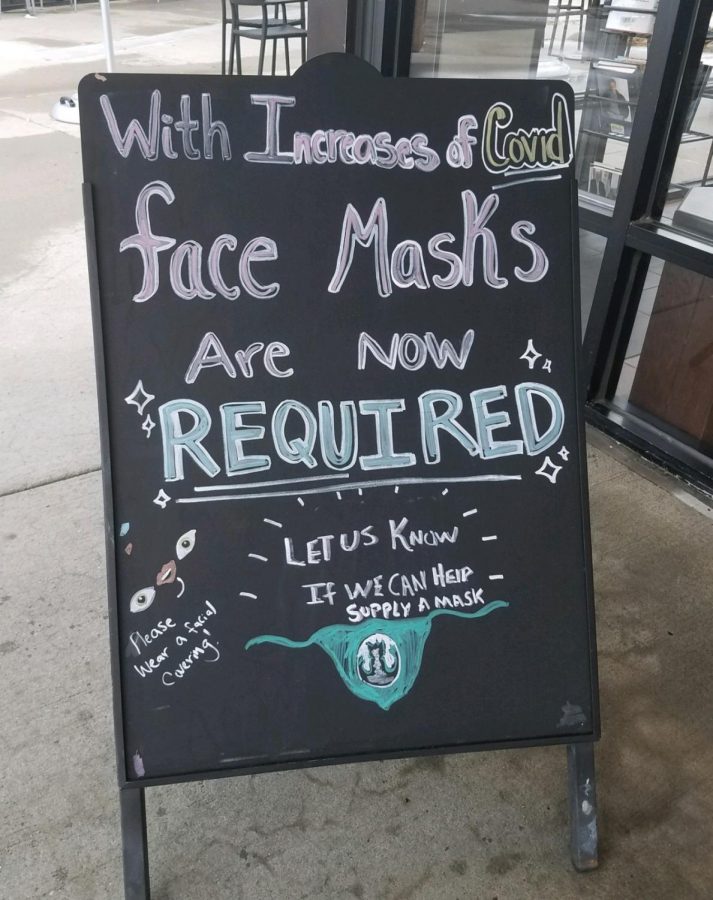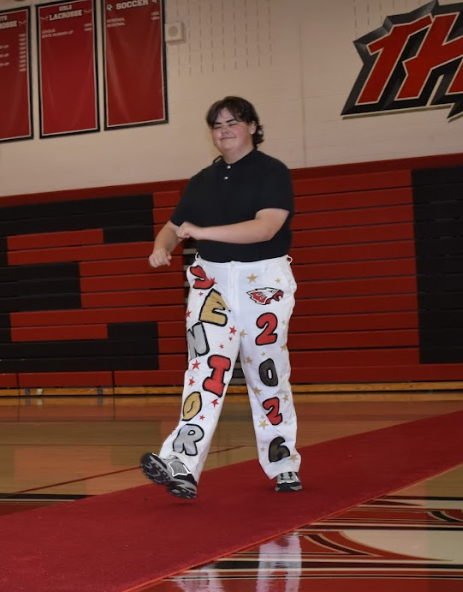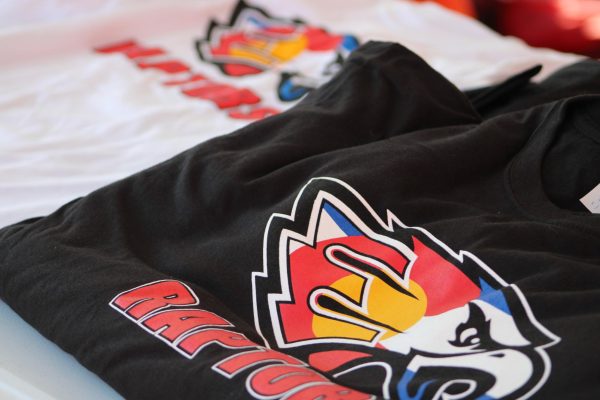An Update on COVID
Going Back to School in a Pandemic
Once Colorado’s mask mandate went into effect, many stores, like this Starbucks, put up signs requiring customers to wear face masks.
The virus COVID-19 is seemingly inescapable. The pandemic, which we once thought might be over by summertime, has now run rampant for over 6 months. And for those 6 months, our world has had to adapt to a global pandemic. Social distancing became a new normal. Masks, hand sanitizer and toilet paper became hot commodities, flying off of shelves.
Cases dropped in some places around the world, but many more places, including the U.S., are now facing rising cases and a potential second wave, according to the World Health Organization. As we know, COVID-19 has incited considerable change in the U.S., from restaurant and store closures to sport season cancellations to overflowing hospitals. And now, as some parts of the country are attempting to reopen and return to a version of normalcy, restaurants and stores are reopening and sports are coming back, albeit in a very different fashion. Many restrictions were rolled back, and in some cases, were put right back into place as many states continue to struggle to contain COVID.
In Colorado specifically, Governor Jared Polis instituted a statewide mask mandate on July 16th, which requires anyone over 10 years old to wear a mask in indoor public spaces and while using public transportation.
“I think it was a good decision,” said junior Esayas Embayea. “It should definitely be required that you wear a mask because masks stop transmissions from what I’ve seen. . . . And you know, masks save lives.”
According to data from the Colorado Department of Public Health and Environment, masks may indeed have saved lives. In 15 out of 20 Colorado regions, the current epidemic curve has been in sustained decline over the past two weeks, while only two regions have seen elevated incidence growth. This means that only two regions have had more than 10 new cases per 100,000 in the past two weeks, which is a definitive improvement compared to the rise in cases that we saw in June. However, despite such an incremental improvement, the situation remains dire in many people’s eyes.
“I’ve become a pessimist about containing [COVID-19],” said English teacher Josh Steiner. “If there’s no enforcement, it’s doomed to fail until we hit rock bottom and have to shut everything down again.” This concern is one that many in the community have voiced, particularly as the Cherry Creek School District made their decision about how to open up schools again.
“The pandemic is clearly affecting our community because many of us have opinions about the best way to move forward with schooling during the pandemic, and there isn’t one objectively correct answer,” said Steiner. There are, of course, many factors to consider when deciding how to reopen schools, and the school district has spent the summer taking in those many different opinions and attempting to determine the best course of action.
Last week, CCSD announced their decision to offer full-time remote learning to all students in the district, and additionally, to offer full in-person learning for students in kindergarten through 5th grade and blended learning for students in 6th through 12th grade.
According to CCSD, “This plan [for blended learning] was developed to primarily adhere to physical distancing requirements, and therefore the student body will be split into two cohorts with half of students attending at one time.” The two cohorts will be divided according to the alphabet; one cohort is comprised of students with last names A through K while the other is comprised of students with last names L through Z.
Blended learning means that students will attend school in person -but still physically distanced- for two days per week and will practice remote learning for the remaining three days. Remote learning will be asynchronous, which means that students will still be required to engage, but can work at their own pace without real-time interaction. However, this could change depending on how the COVID-19 situation progresses throughout the year.
“If In-Person learning must switch to full Remote learning at any point during the year, the instruction will be a mixture of synchronous (students learning online together at the same time) and asynchronous,” according to the CCSD website.
And just as there were many opinions about how school should go back, now that CCSD has a plan, there remain many opinions on the decision.
“The decision made by CCSD was a good decision, compared to the full time that they were saying earlier in the summer. Just deciding to make it blended learning is definitely a way better solution….But it all depends on the execution of it,” said Embayea. Yet he still had reserves about remote learning.
“School just wasn’t meant to be online. It’s more of an in-person experience. I just don’t think you’ll… retain the same amount of knowledge from doing it online,” said Embayea. Mr. Steiner has a different perspective on remote learning, however.
“The quality of learning will only suffer for those who are unwilling to adapt,” said Steiner. “Remote teaching and learning remain uncharted territory for all of us. It’s an incredible opportunity for teachers to learn to be creative and to do things differently. It’s an equally important chance for our students to mature and truly take charge of driving their own education.” The partial switch to remote learning is a change that, according to Mr. Steiner, requires adaptation. However, as we’ve seen countries around the world forced to adapt to the pandemic, we’ve also seen that change isn’t necessarily easy.
“Being in the same physical space with peers or with your teachers is something that can’t be replicated online. That interpersonal connection, that presence, is something that we all hunger for and hope to return to at some point,” continued Mr. Steiner. “However, I completely believe that great things can happen with remote learning due to its potential versatility. It can be so flexible, so accessible, and that’s exciting.”
The pandemic has clearly changed how our community functions physically, with the masks and the change in how we attend school. But it has had a mental effect too.
“For me personally, COVID-19 is impacting me pretty negatively because I’m not able to go out and socialize with my friends,” said Embayea. “I’m spending way too much time at home.” For many, a lack of social contact has been an ongoing struggle, whether that means not being able to see friends or family, or just not being able to feel like part of a larger social collective like a sports team or club.
“I may or may not have my last cross country season and may not be able to experience my senior year fully due to COVID,” said senior Val Mullen. This is a worry shared by many -if not all- seniors this year, but unfortunately, it’s only one of a multitude of things to worry about.
“Until it’s contained, unfortunately, more people are going to die. And no, it doesn’t matter that the mortality rate of the virus is low. What matters is that 150,000 people have died, many more will be infected, and it didn’t have to be this way,” said Steiner. “Long-term, I worry about how our country’s collective mental health will be affected, and I worry about the impact of a future recession.”
In Colorado alone, there have been 48,394 cases and nearly 2,000 deaths due to COVID-19 according to the Colorado Department of Public Health and Environment data. Of those, the majority of cases have been in Denver and Arapahoe counties. As such, there may be a reason to worry. But there is also a reason to remain positive: to be there for others and find a way to adapt to this unprecedented pandemic, according to Steiner and Embayea.
“This year will be far more challenging than last year for all of us due to the fact that there are so many variables in play,” said Steiner. “None of us know what anything will look like. We just have to do our best.” And the best, according to Embayea, is to show people that we’re there for them.
“Whether that be through mail, email, a Snapchat, a DM, a message, a FaceTime call,” he said. “We want to show people that we’re there for them. No matter what way it may be.” Many students agree with the sentiment.
“The Eaglecrest community can still remain a community despite the changes to the school year and social distancing by checking in on each other and being there for your peers and classmates during these difficult times,” said Mullen. With the advent of social media, we are able to connect with one another more than ever, and both Embayea and Mullen urge us to take advantage of that ability. Being able to connect with others has proven in many cases to help ease the struggle of isolation and social distancing.
“As individuals, we have to find a way to find something to smile about every single day. Even if it’s for a matter of minutes,” said Steiner. “As a community, we need to put others before ourselves and understand that it’s okay to be inconvenienced if it means we can save lives. Also, we can stop the needless travel, the needless gathering, and the needless insistence that masks aren’t helpful.” The recommendations of the CDC, including wearing masks and social distancing, remain important even as we attempt to return to work and school, and precautions must still be taken, according to CCSD and Colorado’s own governor.
“I think we can best handle this situation by following the restrictions set in place and by maintaining social distancing to try and prevent further spread of the virus as best as we can,” said Mullen. Despite the desire to return to normal and ignore the restrictions, following the restrictions put in place by the state and recommended by medical professionals can, in fact, help reduce the spread.
“If you’re gonna hang out with your friends, be smart about it….think about who you’re putting at risk. And think about if you’re okay with being put at risk. If they’re okay with you putting them at risk,” said Embayea. “[And] I think something that we could do is, you know, try to go to locally owned businesses and spend your money there….that would really help our community.” Now more than ever, they suggest, community is important. And if there’s anything Eaglecrest is, it’s a community. We can come together and we can make this year a good one.
“If any school can do it, we can. I’ve never worked in a place of such compassion, such trust, and such empathy,” said Steiner. “This is a remarkable place to be.”

Simone Beauchamp is a Senior at Eaglecrest and, as she will let you know, she graduated from Challenge Middle School. She has many talents - photography,...






